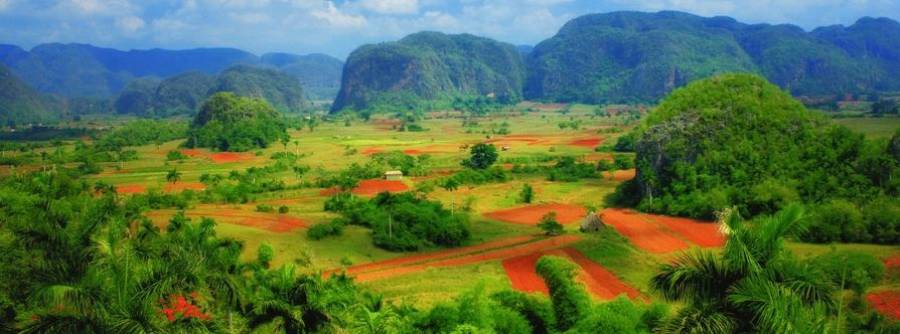Travel to Viñales. Itinerary marked by history and nature
Some researchers attribute to Viñales a history of more than 300 million years, others are only amazed at the mountain range cut by abras that extends north of the province of Pinar del Río. The colonizers, tobacco growers, came from the Canary Islands to settle in the Vuelta Abajo region. In this site it is documented as the first legalization of the land by giving it to Don Andrés Hernández Ramos.
The territory occupied by Viñales belongs to the mountainous group of the Guaniguanico mountain range. It is 132 square km long and is the most prominent of the karst valleys of Cuba. In the valley you can enjoy an unparalleled natural beauty, with 17 endemic varieties. Among them we can find the cork palm, considered a plant fossil dating from the Jurassic and impossible to find in other parts of the planet. The town, site of the settlement of farmers, behind its galleries of columns and red-tile houses, protects the culture of the aboriginal people, the history of local slavery and the work of the peasants …
Many of the vacationers who access these parts stay at the Los Jazmines hotel, which many have called “the viewpoint of the town”, because from the rooms you can enjoy a landscape of exceptional beauty. This hotel organizes exploration excursions through the trails for those interested in the practice of ecotourism. The traveler can also receive accommodation on their trip, in rental houses in Viñales, these accommodation offers are much cheaper than state hotels and are available throughout the island. If your desire is to take a tour with a maximum comfort and privacy we recommend this variant. The houses with a pool (pool) in Havana, the flats, apartments for rent in Vedado and the houses in Playas del Este, can be combined with an itinerary that includes Viñales. This tour would be ideal due to the proximity between both locations.
Among these routes, “The Road to the Mogotes” stands out, which starts at the hotel and goes to the Mural of Prehistory, in the Pita mogote, Dos Hermanas valley. This is one of the largest open-air murals in the world. At 120 meters high and 180 meters wide, it constitutes a unique representation of the biological evolution of the Sierra de los Órganos. The Cuban professor Leovigildo González, then Director of Cartography of the Academy of Sciences of Cuba, now deceased, was in charge of materializing the artistic project of the mural. He counted on the collaboration of the villagers in the dangerous prior removal of the topsoil from the hillside. The rock was washed and drains were made to prevent erosion from the rain.
Every year, thousands of visitors come to see the representations of the Guanahatabeya Indians, with the images of plesiosaurs and the megalonus rodens, as well as some mollusks. Together they add up to 12 pieces of the evolutionary process of men and animals.
Other routes to be followed by tourists are: “Unsuspected Nature”, a route where the rich and varied birdlife is appreciated and “The Secrets of an Underground World”, for those who show speleological interest.
They are marked in the itinerary: The Great Cavern of Santo Tomás, classified among the largest in Latin America, exceeding 45 km of galleries, characterized and surveyed by Dr. Antonio Núñez Jiménez; and the Cueva del Indio, which reaches 300 meters in length, crossed by the San Vicente River and near the palenque of the Maroon village.
The Alturas de Pizarras, of the existing elevations in the valley, are made up of a variety of rocks, the oldest in the country and in the Caribbean area. Visits to the House of Charity, Botanical Gardens; to the National Park, where metamorphic rock heights are combined with karst mountains and extensive cave systems known worldwide as the “Cathedral of the Tropical Carso”; and the village nightclub, built in a cave, can complement the alternatives.
The accommodation options are varied: in addition to the La Ermita, Los Jazmines and Rancho San Vicente hotels, the service of private residences licensed to operate as a pension stands out.
One such visitor described the Viñales Valley on Tripadvisor: “I am an adventurer. This month I packed my backpack with a few things and went to Viñales, I learned about new routes and the work of Cubans. I delight in their food, typical of the area. For all this I prefer that you live it in person. “
Do you consider that Viñales has the most beautiful landscapes in Cuba?


Comment (0)